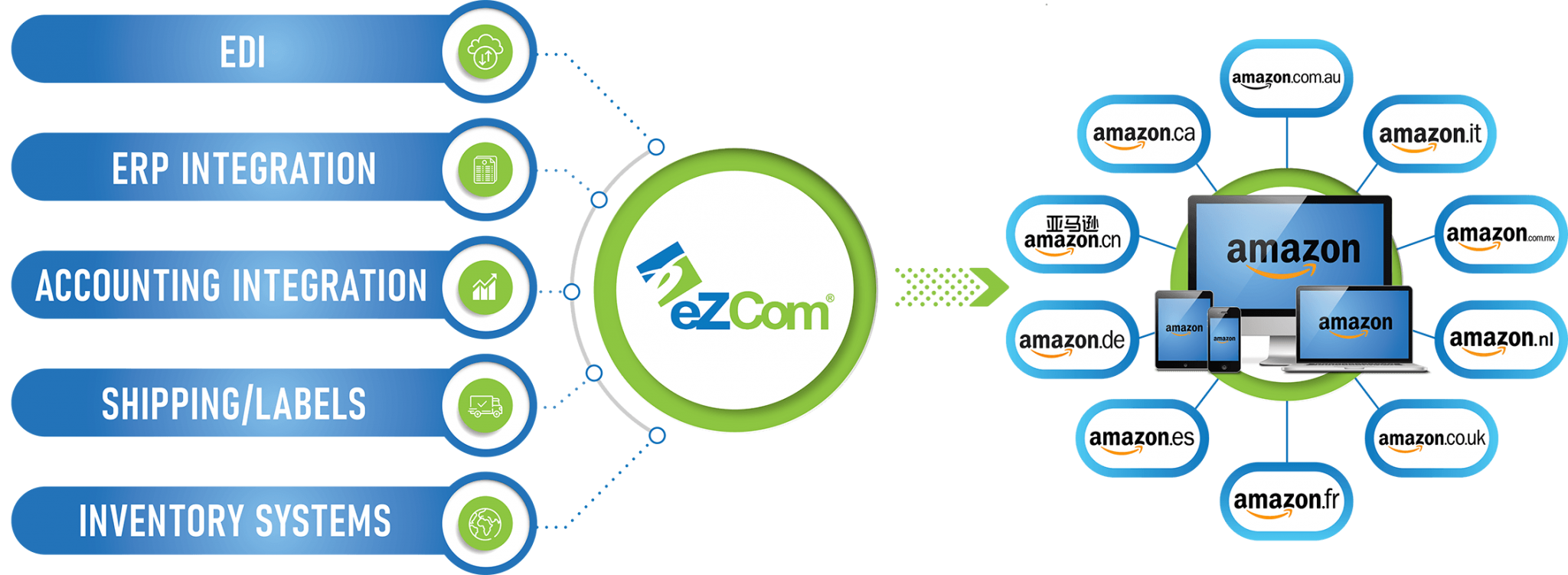Chances are, Amazon sales are a key piece of your overall revenue picture. With online sales more important than ever, it’s hard to avoid the world’s largest channel. But how well do you manage your Amazon orders? Is there room for improvement? We have a solution. Integrate Amazon Vendor Central and Seller Central orders.
Whether you’re on Amazon Vendor Central or Amazon Seller Central, integrating EDI transactions and online orders will create efficiency and save you time. You’ll have fewer mistakes that lead to chargebacks or returns. The customer experience will improve, and happy buyers make repeat purchases. Fewer hours will be spent processing Amazon orders by your team, and that time can be used to focus on cultivating more sales.
While there are different ways to sell your products on Amazon, integration will produce efficiency no matter which way you choose.

Amazon Vendor Central With EDI
Amazon Vendor Central follows the traditional wholesale model. As a supplier, you sell your products to Amazon, and then the products are priced and shipped by the company. Amazon maintains the inventory, and is free to set the retail price. Suppliers that use Vendor Central give up some control to Amazon in exchange for the market opportunity it provides. Sales volume should increase, and there’s less for you to manage compared to Seller Central.
What Does It Take To Connect On Amazon Vendor Central
Vendor Central connections are through EDI. Unlike Seller Central, there is no API available for Vendor Central. The connection is X12 in the United States—EDIFACT in Europe. You’ll also need a GS1 prefix to sell on Vendor Central.
It is possible to connect without EDI on Vendor Central through the vendor portal. But it’s manual, time-intensive, and inefficient. If you have any volume, the process can consume as many as 20 hours of time per week for the person managing Amazon orders. Using EDI offers advantages any Vendor Central supplier can’t ignore.
With our Lingo software, you can integrate EDI with the system that powers your business to make managing Amazon even easier. That can be an ERP, your accounting software, a WMS, or the system that a 3PL partner runs. Our connections to Amazon will dramatically reduce time-consuming, error-prone copy-and-paste efforts, and allow you to process orders in bulk instead of one at a time.
Branded packing slips, required for Amazon Prime, are available through Lingo. You can also enjoy direct connections to shipping providers, saving time on direct-to-consumer orders that you receive through Vendor Central.
The EDI documents typically used for Amazon transactions are:
- 850 (Purchase Order)
- 855 (Purchase Order Acknowledgment)
- 856 (ASN)
- 810 (Invoice)
- 846 (Inventory Advice/Update—optional but mandatory for Direct-to-Consumer)
- 753 (Request for Routing Instructions—optional)
- 754 (Routing Instructions—optional)
Amazon Seller Central With FBA or FBM
On Amazon Seller Central, suppliers are third-party sellers. That provides more control over pricing and often higher per-item margins. Many suppliers build their own Amazon store.
In exchange for greater control, selling through Amazon Seller Central is more demanding. Suppliers manage their own listings, assuming the responsibility for marketing, inventory maintenance, fulfillment, and Product Description Pages.
Suppliers that choose Fulfilled by Amazon (FBA) provide stock that Amazon holds at its distribution centers to ship when a purchase is made. With Fulfilled by Merchant (FBM), products are shipped to customers directly from the supplier.
What Does It Take To Make Amazon Seller Central Seamless?

Let’s start with this—Amazon Seller Central requires more work by the supplier to sell products. You’re not simply selling with a wholesale model to Amazon and shipping large orders. You’re listing your products, and you need to deliver a first-rate customer experience to buyers.
If you have to do more work, how can you do it in less time? If you choose Fulfilled by Merchant (FBM), you’ll be handling direct-to-consumer orders that are inherently time-intensive. Instead of shipping hundreds of items to a distribution center or a group of stores, you’re sending single items to customers at their home address. Seller Fulfilled Prime comes with its own challenges, and you will be expected to process orders according to Amazon standards.
It can take an outsized amount of resources to stay on top of everything, and that may make profits from this kind of business disappointing.
Even if your only business is sales on Amazon using FBM, our software will make your operation more efficient. If you’re adding business through Amazon Seller Central to an existing roster of trading partners that use EDI, Lingo makes it easy because you’ll be able to manage all your orders the same way. In other words, those single orders through Amazon Seller Central will be managed alongside larger EDI transactions with your other trading partners, all with the Lingo platform.
What’s more, when customers order, you’ll be responsive. With the data integrated, order information will flow into the system that powers your business—an ERP, accounting software, WMS—faster. The time you save by eliminating manual entry will let you process all orders more quickly. It’s no secret that today’s consumers are impatient—we have all been conditioned to expect instant gratification—so time is of the essence. Process the order quickly, get it moving through your supply chain faster, and you’ll wind up with a customer who is happy with your company. That translates into more repeat sales and greater profits from your Amazon business.
Finally, if you use Amazon Seller Central with Fulfilled by Amazon (FBA), you can build connections between Amazon and your warehouse with the Lingo API. This makes it easy to notify Amazon that items are being shipped to a FBA distribution center. Using the API, you can also print labels and communicate to your warehouse that goods need to be packed and shipped.
If your business already ships globally or you hope to eventually expand your scope, our Lingo software connects with Amazons around the world, including:
- Amazon Australia
- Amazon Canada
- Amazon China
- Amazon France
- Amazon Direct Fulfillment
- Amazon Germany
- Amazon Italy
- Amazon Mexico
- Amazon Netherlands
- Amazon Spain
- Amazon UK
- Amazon United States
It’s the rare brand that doesn’t have Amazon among its sales channels. Selling on it offers extraordinary opportunities—no other site has the reach with online shoppers—but also presents challenges. Some of the Amazon requirements are onerous, and the direct-to-consumer element must be managed well to be profitable.
Integration can make all the difference. Using our Lingo software and integrating it with the system that powers your business, or using our documentation for an API, will help you manage Amazon efficiently and produce maximum profits.







